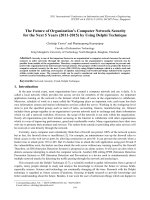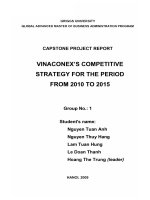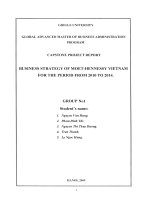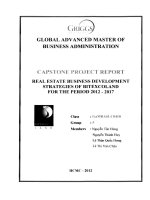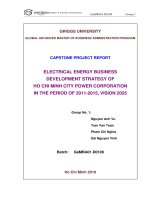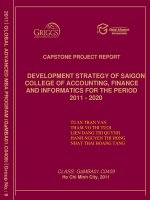Strategy of abbank’s retail banking development for the period 2011 - 2020
Bạn đang xem bản rút gọn của tài liệu. Xem và tải ngay bản đầy đủ của tài liệu tại đây (1.38 MB, 82 trang )
GRIGGS UNIVERSITY
GLOBAL ADVANCED MASTER OF BUSINESS ADMINISTRATION PROGRAM
CAPSTONE PROJECT REPORT
STRATEGY OF ABBANK’S RETAIL
BANKING DEVELOPMENT FOR
THE PERIOD 2011 - 2020
Group Number:
01
Student’s name:
Nguyen Thi Huong Giang
NguyenDuy Vinh
Dang Anh Tuan
Le Thi Hien
Giang Thi Thu Huong (X0309)
HA NOI 2011
Strategy of ABBANK‟s retail banking development for the period 2011 - 2020
GaMBA.X0409 - Group 1 i
ACKNOWLEDGEMENTS
First of all, the members of Group 1 would like to thank sincerely to the ETC
Training Centre, National University and Griggs International University, the
United States to facilitate us to study in a practical and rewarding program.
Especially, we would like to deeply thank to the teachers who taught in the program
for their precious knowledge and the tutors of the class for their invaluable
assistance to help our group completed this graduation exercises.
The content presented in this exercise is to apply the knowledge learned in
the program to analyze the state of An Binh Commercial Joint Stock Bank and to
develop a retail banking strategy for the bank in the period 2011 - 2020. So, the
analysis and contents in this exercise are completely of our group member’s
opinions and efforts.
However, due to the limit of the time, this capstone project contents may be
inevitable misunderstood and flawed. Therefore, we look forward to receiving
comments from the readers as well as the teachers so that we can improve our
capstone project better.
Best regards,
Strategy of ABBANK‟s retail banking development for the period 2011 - 2020
GaMBA.X0409 - Group 1 ii
TABLE OF CONTENT
ACKNOWLEDGEMENTS i
TABLE OF CONTENT ii
LIST OF ABBREVIATION iv
LIST OF FIGURES, GRAPHS AND TABLES v
INTRODUCTION 1
i. Urgency of research theme 1
ii. Purpose of research 3
iii. Research method: 3
iv. Structure of theme: 3
CHAPTER I: THEORIES OF STRATEGIC MANAGEMENT. 4
1.1 General concept 4
1.1.1 Concepts of strategy 4
1.1.2 Concepts of strategic management 6
1.2 Foundations of strategy 7
1.2.1 Role of strategy 7
1.2.2 Types of strategy 8
1.3 The process of strategic management 9
a. Process of forming strategy. 9
b. The process of implementing strategy 11
1.4 Steps for establishing a strategy 13
1.4.1 Definition of mission, vision and core value: 13
1.4.2 Analyze of external environments. 14
1.4.3 Analyze of internal environment. 15
1.4.4 Selection of strategy 15
1.5 Techniques for strategy analysis 16
1.5.1 PEST analysis 16
1.5.2 Analysis of M.Porter’s five forces model 17
1.5.3 SWOT analysis 19
Strategy of ABBANK‟s retail banking development for the period 2011 - 2020
GaMBA.X0409 - Group 1 iii
CHAPTER 2: ANALYZE THE STATE OF AN BINH COMMERCIAL
JOINT STOCK BANK (ABBANK) 21
2.1 General introduction of ABBANK 21
2.1.1 History of ABBANK’s development 21
2.1.2 Developmental milestones 21
2.2 Analyze the state of An Binh Commercial Joint Stock Bank 22
2.2.1 Analyzing factors of external environment 22
2.2.2 Opportunities and threats for retail banking. 32
2.2.3 Analysing internal environment 33
2.2.4 ABBANK‟s opporturnities, threats strength and weakness 51
CHAPTER 3: STRATEGY FOR DEVELOPMENT RETAIL BANKING OF
AN BINH COMMERCIAL JOINT STOCK BANK FOR THE PERIOD 2011 -
2020 55
3.1 Vision, mission and core value. 55
3.2 Targets of ABBANK’s retail banking development for the period 2011-
2020 56
3.3 Strategic analysis and selection. 57
3.4 Several solutions for retail banking development 59
3.4.1 Construction for organizational model of retail banking 60
3.4.2 Development of human resources 61
3.4.3 Investment into information technology: 65
3.4.4 Network development 66
3.4.5 Developing products 66
3.4.6 Marketing and trademark development 68
3.4.7 Risk management 72
3.4.8 Business culture of retail banking 73
3.4.9 Implementation schedule 74
CONCLUSION 75
REFERENCES 76
Strategy of ABBANK‟s retail banking development for the period 2011 - 2020
GaMBA.X0409 - Group 1 iv
LIST OF ABBREVIATION
ACB
Asia Commercial Bank
ATM
Automatic Transfer machine
ASEAN
Association of South-East Asian Nations
CD
Certification of Deposit
CCG
Corporate Customer Group
GDP
Gross Domestic Product
HSBC
Hongkong Shanghai Bank Corporate
IMF
International Monetary Fund
IT
Information Technology
ICG
Individual Customer Group
L/C
Letter of Credit
NPL
Non Performance Loan
ODA
Official Development Assistance
POS
Point of Service
ROA
Return On Assets
ROE
Return On Equity
SBV
State Bank of Vietnam
SMS
Short Message Service
SOB
State Owner Commercial Bank
POB
Private Owner Commercial Bank
T.Os
Transaction Offices
WTO
World Trade Organization
USD
United State Dollar
VND
Vietnam dong
Strategy of ABBANK‟s retail banking development for the period 2011 - 2020
GaMBA.X0409 - Group 1 v
LIST OF FIGURES, GRAPHS AND TABLES
Figure 1-1
Process of strategic management
11
Figure 1.2
The basic model of strategic management
14
Figure 1.3
Eight activities of the strategy implementation and operation
16
Figure 1.4
Basic steps of strategic management
17
Figure 1.5
M.Porter’s five forces model
21
Figure 1.6
SWOT matrix
24
Figure 2.1
Structure of lending market share of credit institutions
32
Figure 2.2
Structure of mobilization market share of credit institutions
32
Figure 2.3
Organization chart of ABBANK
40
Table 2.1
Results of business operation in 2008, 2009, 2010
41
Figure 2.4
Structure of lending, mobilization of Individual Customer
Group and Corporate Customer Group
43
Table 2.2
Banks’ criteria of total assets in 2009
46
Figure 2.5
Banks’ market share of loan, mobilization in 2010
48
Table 2.3
Quantity of branches/transaction offices and competitive banks
50
Strategy of ABBANK‟s retail banking development for the period 2011 - 2020
GaMBA.X0409 - Group 1 1
INTRODUCTION
i. Urgency of research theme
In the process of restructure of the Vietnamese commercial banks, the
development of retail banking and wholesale banking is rising in the planning and
implementing strategy of each bank system as well at the macro level of State Bank.
We are witnessing the development and keen competition of services of Vietnamese
banks, especially retail block. Retail banking service is the new way of looking at
financial market, therefore, major of small and retail work-people will be approach
to banking products and services, making a creative, various and potential market.
Today, competition in banking is the hot issue of the economy; the
commercial banks develop incessantly the services and products with expectation of
becoming the top special leader in retail services that are banking services connect
closely to the multi-purpose and modern technology towards to major individuals
and medium and small businesses. Modern banking services have become habit of
most of people in the world, but quite fresh to Vietnamese people.
Besides, in the condition that the open economy, trade liberation and finance
liberation have been wide and deep, demand for banking - financial services can
develop quickly and beyond capability of satisfying of current financial
intermediate institutions in the country. This is the point attracting the foreign
financial organizations to control domestic market, especially when barrier of
financial market in Vietnam is removed, and since 01/04/2007, State of Vietnam
has permitted the Bank 100% foreign capital to establish in Vietnam according to
the commitments in WTO integration. It is actually that people’s demand for using
banking - financial services is increasing. That demand connects closely to the
quickly forming process of business form in the economy, as well as the
transferring process from State-own enterprise to Joint Stock Company. That is the
demand for stock transaction, investment consulting, financial lease and purchase,
debt management …. At the same time, the appearance of foreign enterprises in the
Strategy of ABBANK‟s retail banking development for the period 2011 - 2020
GaMBA.X0409 - Group 1 2
economy plays a role as catalyst, to promote the appearance and quick development
of market demand for banking - financial services. Those are services relating to
non-cash payment, automatic withdraw, remittance services … Obviously, demand
for the form of banking – financial service is initiatively, as breakthrough, and
motive the appearance and development of supply resource of domestic services.
Therefore, the market of modern and new services of banks in Vietnam
nowadays is the potential market which is ready to receive the new financial
instruments and supply resource in the market. Although the commercial banks is
still sponsored by State Bank of Vietnam through the limit of establishment of joint
venture banks or 100% foreign capital; the commercial banks in Vietnam have
determined that in the current situation and in the future, they will not sit tight to
take advantages of domestic market as before, a lot of banks determined that
development of retail banking services is the important part of their development
strategy; beginning from the grasping opportunity from new market, from applying
technology and using system to create many new products and services, effective
mean of distribution, enhancing relationship between customers and banks.
Actually, we see that the opinions of banks’ leaders are the same in development
orientation of their banks such as:
“The application of IT to create new products is the target of almost banks
nowadays. VietinBank will make a lot of new products allowing customers to use
financial transactions in Internet and on mobile”. Mr. Le Viet Bac, Chief of E-
banking Services Department (VietinBank) said.
Or Mr. Hoang Trung Dung, Director of company customer of Maritime Bank
Vietnam said: “We will develop through quality of banking services, and expand
market share through utility products and services”.
And Mr. Nguyen Hung Manh, General Director of An Binh Commercial
Bank said that: “An Binh will strengthen in investment in infrastructure, especially
IT in the orientation of retail banking development; expanding cooperation with
partners to bring utility products to many people more and more…”
Strategy of ABBANK‟s retail banking development for the period 2011 - 2020
GaMBA.X0409 - Group 1 3
Based on the above fact as well as according to the opinion and development
orientation of General Director of An Binh Commercial Bank, the group has chosen
the theme: “Development strategy for retail banking of An Binh Commercial Bank”
to be the research theme in exercise with expectation to contribute a small part in
the strategic planning at An Binh Commercial Bank.
ii. Purpose of research
Applying the knowledge learned on the subject of strategic management to
explore opportunities and threats of the banking sector especially in retail banking
area. Also, through the analysis of the internal environment of the An Binh
Commercial Joint Stock Bank (ABBANK) to understand its strengths and
weaknesses associated with the use of SWOT matrix to select the most effective
strategy for ABBANK’s retail banking development in the period 2011 to 2020.
iii. Research method:
In the research method, the theoretical models of strategic management are
mainly used to apply in the specific condition of An Binh Commercial Bank in
order to form a business strategy.
In the theme, methods of statistics, reason, comparison, judgment and summary
are used through internal data of the An Binh Commercial Bank, data of the other
commercial banks, teaching materials in strategic management in domestic and
international countries and through magazines resource, internet to research.
iv. Structure of theme:
Chapter 1: Theories of strategic management
Chapter 2: Analysis the real situation of An Binh Commercial Joint Stock
Bank (ABBANK).
Chapter 3: Strategy of ABBANK’s retail banking development for the period
2011 -2020.
Strategy of ABBANK‟s retail banking development for the period 2011 - 2020
GaMBA.X0409 - Group 1 4
CHAPTER I: THEORIES OF STRATEGIC MANAGEMENT.
1.1 General concept
1.1.1 Concepts of strategy
There are many concepts of strategy, those concepts have one or more than
one difference depending on each author’s conception, and we will bring out
some concepts of strategy as follows:
- According to Chandler, in 1962 “Strategy is the determination of long-
term basic purpose and target of enterprise and the application of a series
of actions as well as distribution of necessary resources in order to carry
out this target” (Source: Chandler, A. (1962). Strategy and Structure.
Cambridge, Massachusetts. MIT Press.)
- According to Quinn “Strategy is pattern or plan which integrate the main
targets, policies and series of actions into the general united closely.”
(Source: Quinn, J., B. (1980). Strategies for change: Logical
Inscrementalism. Homewood, Illinois, Irwin.)
- According to William F.Gluek: “Strategy is the united, comprehensive
and co-ordinate plan, designed to ensure that the enterprise’s basic
targets will be complemented successfully. However, this perspective
isn’t actually sufficient, it is practically proved that: Sometimes the
official plans scheduled concretely are unsuccessfully".
- According to Johnson and Scholes: “Strategy is the orientation and
scope of a organization in long term in order to gain competitive
advantage for the organization through formatting its resources in the
changing environment, in order to meet demands of market and satisfy
the related parties’ expect” (Source: Johnson, G., Scholes, K. (1999).
Exploring Corporate Strategy, 5
th
Ed. Prentice hall Europe.)
- According to Mintzberg, strategic management is:
Strategy of ABBANK‟s retail banking development for the period 2011 - 2020
GaMBA.X0409 - Group 1 5
+ Plan: Series of actions intended consistently.
+ Patten: Consistency in behavior in time line intended or not intended.
+ Position: appropriate between organization and its environment.
+ Perspective: method to deeply aware of the world.
+ Ploy: concrete method to deceive opponent.
Definition of strategy not only includes the different aspects, but also various
depending on level. Substantially, the exact definition of strategy according to level
depends on perspective. At least, 3 strategy levels need identifying: strategy at
company level; strategy at business unit level and functional strategies.
Enterprise development strategy: “A series of commitments and actions
applied by enterprise to gain a competitive advantage by exploiting the core
capacities in the decisive market”.
In summary: Generally, it is obligatory to meet sufficiently the following
factors when forming strategy:
- Being set up for a long time;
- Creating growth for organization;
- Using all of the resources of organization effectively;
- Making the best competitive position for organization in the future.
We can say that strategy "is a series of long-term actions formed to make an
organization from the current position to the expected position in the future by
setting up the competitive capacity compared to advantages of the other
organizations in the market” (Michael E. Porter (1996) What is strategy?, Harvard
Business Review).
Strategy is an orientation and scope of an organization in long term in order to
gain competitive advantage for the organization through formatting its resources in
Strategy of ABBANK‟s retail banking development for the period 2011 - 2020
GaMBA.X0409 - Group 1 6
the changing environment, in order to meet demands of market and satisfy the
related parties’ expect.
1.1.2 Concepts of strategic management
People usually consider strategy as a product of a reasonably formed process
guided by superior manager, but not efficiently. In many cases, the valuable
strategies can be arisen in the organization without planning.
Strategic management is a series of the management decisions; and the
actions which define the long-term productivity of a company. Strategic
management includes continuous actions: Examining environment (both internal
and external); building strategy; implementing strategy and evaluating strategic
control. Therefore, strategic research stresses the monitor and evaluation of the
external threats and chances in the context of internal weakness and strengths.
Strategic management is the process of arranging flexibly strategies, operation
situation and business results, including personnel, leaders, techniques, and
treatment methods.
Strategic management can be defined as the artistically and scientifically
formation, implementation and valuation of the decisions related to functions which
are enable a organization to reach its planed target.
As we show in this definition, strategic management focuses on unifying the
management of marketing, finance, production, development research and systems
of information on business fields in order to gain organization’s success.
The process of strategic management includes 3 periods: Setting up strategy,
implementing strategy, and valuating strategy. Strategy formation period includes:
developing the business missions, determining the external chances and threats,
clearly defining the internal strengths and weaknesses, setting up the long-term
targets, creating the alternative strategies and choosing the specific strategies to
pursue.
Strategy of ABBANK‟s retail banking development for the period 2011 - 2020
GaMBA.X0409 - Group 1 7
From the definitions of strategy and strategic management stated above, we
can see that the basic content of strategic management includes: Determining the
main organization’s mission and target; analyzing the external and internal
environment of an organization; choosing a strategy corresponding to strengths and
weakness and chances, threats; accepting organization’s structure and control
systems to carry out the chosen strategy.
Figure 1-1: Process of strategic management
1.2 Foundations of strategy
1.2.1 Role of strategy
- To reach the enterprise’s target in long term (business and social
responsibility), sustainably.
- How can the enterprise hold the upper hand compared to competitors in the
market, with the concrete customer objects?
Strategy of ABBANK‟s retail banking development for the period 2011 - 2020
GaMBA.X0409 - Group 1 8
- Which resource does the enterprise need to use (human, skills, property,
finance, and technologic secret …) to be able to reach the planned target?
- To see the implicit chances and threats from external environment can
affect the implementation of enterprise’s target: environment, competition,
policy, natural resources … plans for preventing risks.
- To help the business manager to clearly realize that the strengths,
weaknesses, chances and threats can occur in business at present and in the
future, to analyze and forecast the conditions in the business environment in
the future. To help the enterprise to take full advantage of chances, to
decrease risks, and to increase the enterprise’s competitive capacity.
- To help the enterprise to build the business strategy better through using
“system approach” method, creating foundation to increase association and
attachment among members in the implementation process of enterprise’s
target.
1.2.2 Types of strategy
a. Classification according to strategic levels:
Strategy at company level (general strategy): Strategy at company
level towards the organization’s general scope and purpose.
Strategy at business unit level (field): Strategy at business unit level
relates to the successfully competitive mode in the concrete markets.
Strategy at functional level (or operation strategy) is the strategy
which helps strategy at business level and at company level to be
implemented effectively by component parts in aspects such as
resources, processes, human and necessary skills.
Today, with the globalization tendency, companies are quickly
diversifying their activities beyond national border; thence, global strategies
are considered as a choice to cope with the problems in international business.
Strategy of ABBANK‟s retail banking development for the period 2011 - 2020
GaMBA.X0409 - Group 1 9
b. Classification according to contents of strategy.
+ Trading strategies
+ Financing strategies
+ Human strategies
+ Technology strategies and technical strategies
c. Classification according to development processes:
According to this classification, the strategy includes:
Oriented strategies: refer to the great orientation of enterprise’s target.
It is formed based on the result of environmental analysis and internal
enterprise analysis.
Operation strategies: are enterprise’s methods of operations under
each concrete circumstance and plans to adjust strategies.
1.3 The process of strategic management
Strategic management is a series of the management decisions; and the actions
which define the long-term productivity of a company. Strategic management
includes continuous actions: Examining environment (both internal and external):
(i) forming strategy; (ii) implementing strategy and (iii) evaluating strategy.
Therefore, strategic research stresses the monitor and evaluation threats and
opportunities of the external environment in the context of internal weaknesses and
strengths.
a. Process of forming strategy.
This is the most important period in the process of strategic management
including 3 steps:
- Step 1: Choosing the company’s main target and mission.
Strategy of ABBANK‟s retail banking development for the period 2011 - 2020
GaMBA.X0409 - Group 1 10
- Step 2: Analyzing external environment to define opportunities, threats and
analyzing internal environment to define the organization’s strengths and
weaknesses.
- Step 3: Choosing strategies based on seeking resources, ability, core
competencies, and developing them to overcome the threats, to utility the
opportunities from the external environment.
The process of forming strategy can be carried out according to the basic
model of strategic management (figure 1.2)
Figure 1.2: The basic model of strategic management
Strategy of ABBANK‟s retail banking development for the period 2011 - 2020
GaMBA.X0409 - Group 1 11
b. The process of implementing strategy
After finishing the process of forming strategy, the chosen strategy will be
carried out through the clear identification of development target in each period, for
each department; changing the organization’s structure (if needed) and working out
production plans, business plans, creating the necessary and appropriate resources.
Strategy implementation is the method which a company creates the
organizational arrangement allowing them to pursue their strategy most effectively.
The organizational design means that choosing mode of coordination between
organization’s structure and control system for the company in order to pursue its
strategy effectively, to create the value and the firm competitive advantage.
In practice, many companies have set up strategy but unfeasibly due to
shortage of necessary capacity to implement plan. The implementation is the
process from up to down.
Purposes of implementation of strategy are: Building capacity, ability and
resource; building up budget; setting up policies and regulations to support and
choose the best activities and promote continuous innovation, building the
information and connection system and operating; attaching a reward/ punishment
to target to promote the implementation of strategy; creating working environment
to carry out strategy better.
The necessary component parts of the strategy implementation process are
shown in the figure 1.3 below:
Strategy of ABBANK‟s retail banking development for the period 2011 - 2020
GaMBA.X0409 - Group 1 12
Figure 1.3: Eight activities of the strategy implementation and operation
In the strategy implementation process, leader board is the key component
part contributing to the success of the strategy implementation process. Leader has
to be usually ready with awareness “what to do” to gain the expected result. They
build the competent organization by choosing the peoples suitable to the key
positions, to guarantee that the organization will have enough skills, capacity,
management skills, technologic secrets, competitive capacity and proper resources.
Simultaneously, they combine the organization’s structure with the strategy under
implementation, unify whole organization to act for strategy, create commitment,
shape a mobilization, implement strategy and attach mode of organization to carry
out activities to the strategy’s requirements.
a. Stage of strategic audit
This is the final stage of strategic management process. Strategic control is a
process in which administrators shall encourage and supervise the implementation
of each organization as well as its members in order to assess whether activities are
carried out continuously and effectively or not. Consequently, the company shall
Strategy of ABBANK‟s retail banking development for the period 2011 - 2020
GaMBA.X0409 - Group 1 13
make adjustment decisions to improve for better efficiency. Contents for control can
include: the control of efficiency, quality, improvement and customer satisfaction
degree
In brief, strategic management process consists of basic steps in the
following model:
Figure 1.4: Basic steps of strategic management
1.4 Steps for establishing a strategy
1.4.1 Definition of mission, vision and core value:
a. Definition of the organization‟s mission:
Mission is a declaration aiming at informing of the existence of the Enterprise,
which defines values and rules governing the Enterprise, and is a vital part during
strategic planning process. Mission of the company is the reason for the existence of
the company on the market, who you are and what kinds of products and services you
shall bring to customers and the community.
b. Definition of vision:
Vision is an image, a lively picture about what shall happen to a trade mark in
the future. It is the choice of one of the most wonderful values of a trade mark.
Vision is also characterized by the uniqueness, implying to create something
special.
Strategy of ABBANK‟s retail banking development for the period 2011 - 2020
GaMBA.X0409 - Group 1 14
Hence, a declaration about vision is considered as a report on the position your
company desires to achieve. Vision declaration outlines the future of your company
when you gain your own target and purposes.
c. Definition of core value:
- Core value helps to form the psychology for enterprise, which can
support or reject the personal psychology accordingly.
- Being values deeply rooted in the enterprise.
- Being a belief system influencing the behavior between individuals or
among groups of people.
- Core values are “the soul” of the enterprise.
- Core values are essential and long-term guidance rules.
- Helping enterprise to orient its decisions and actions.
1.4.2 Analyze of external environments.
Analyze the external environment in order to find the opportunities and
challenges from the environment outside of the business. Three types of external
environment have been linked together include: the macro environment, national
environmental and industry environment in which enterprises are operating.
Enterprises identify opportunities and challenges through analysis of data on
changes in the environment where businesses are operating or planning to enter.
Opportunities may include market potential, market space, close to the resources or
skilled and cheap labor forces. The challenges for the enterprise may be the narrow
market, increasingly fierce competition; changes in policy, political instability in
key markets or new technologies development make facilities and production lines
of business becoming obsolete.
Strategy of ABBANK‟s retail banking development for the period 2011 - 2020
GaMBA.X0409 - Group 1 15
1.4.3 Analyze of internal environment.
Analyze of internal environment is to find the strengths and weaknesses of
the business.
By analyzing the internal environment of business, the strengths of the
business organization may be the skills, resources and advantages that businesses
get ahead of competitors (the key capacity of businesses) as there are many talented
executives, have advanced technology, famous brand, available cash, businesses
have a good image in the eyes of the public or a large market share in the key
market. The weaknesses of the enterprise reflected the shortcomings or
disadvantages of skills, resources or other factors limiting the competitiveness of
enterprises. That may be the inefficiency distribution network, bad labor relations,
lack of international experienced managers or outdated products and services
compared to competitors.
1.4.4 Selection of strategy
Selected strategic plans are corresponding to the strength, weakness,
opportunities and threats determined by the company. Obvious awareness of nature
of competitive advantage basing on analysis is to find out resources, capability and
core competency as the bases for development and selection of strategy.
The organization has to assess many plans corresponding to abilities for
achievement of principal target. Created strategic plans can include at business unit
level, functional level, company level or global strategy allowing the best existence
suitable for the quick change of global competitive environment.
Selecting business strategy is the orientation to develop and build competitive
advantage of businesses that rely on understanding and assessing the situation has
been made in the above steps. Enterprises can choose strategies according to three
groups of strategies:
- Strategy of the cost leader. (Lowest price)
Strategy of ABBANK‟s retail banking development for the period 2011 - 2020
GaMBA.X0409 - Group 1 16
- Centralized strategy (focus on a market or a certain market segments or
focus on a certain product groups.)
- Differentiation strategy.
In summary: Best strategy is to have high feasibility and be appropriate to the
strengths and resources of the enterprise, and aiming at grasping at the best
business opportunities, and establishing the defensive barrier against the
competitors’ risks which can harm interests of the enterprise
1.5 Techniques for strategy analysis
Techniques for strategy analysis are used in this research subject including:
1.5.1 PEST analysis
Legal and political environment: Legal, political factors impact on
development strategy of the enterprise in various directions. Sustainability of
politics and completion of legal system are always the big concern of business
manufacturers.
Economic environment: Real situation of economy and future trade have an
influence on the enterprise’s success and strategy. Changes of principal factors are:
economic growth rate, interest rate, inflation, unemployment, exchange rate which
all impact on the enterprise.
Social-cultural environment: For strategic management, cultural and social
factors are sensitive matters and have changes. Lifestyle of people quickly alters
following the integration trend, leading to the change of consumption attitude. The
higher intellectual level of people is, the higher the consumer’s need for quality,
diversity of product category is.
Technological environment: Technological factor has a great influence on
business strategy of the enterprise and industrial sectors as well. The change in
technology considerably influences life circle of products and services.
Consequently, the enterprise needs to have sound judgments on technology, aiming
Strategy of ABBANK‟s retail banking development for the period 2011 - 2020
GaMBA.X0409 - Group 1 17
at creating opportunities for the enterprise in the development of products and
services.
Through the analysis process of external environment, business managers can
assess the opportunities and threats to their enterprises. Accordingly, entrepreneurs
shall have foundations to build and choose development strategy in a right and
objective way. Changes in macro strategy can directly impact on any forces in the
sector, which therefore alter relative strength to other forces and to it, finally
changing attraction of one sector.
1.5.2 Analysis of M.Porter‟s five forces model
Analysis of sector environment needs the assessment of competitive structure
within a sector, including competitive position of a central organization and
principal competitors, and development stages of the sector as well.
M. Porter, professor of Harvard Business School draws out a framework
which helps administrators find out opportunities and threats facing the enterprise in
the sector.
Figure 1.5: Michael Porter‟s five forces model
According to Michael E. Porter, competition in an industry depends on five
basic factors, such as the bargaining power of customers; bargaining power of
Strategy of ABBANK‟s retail banking development for the period 2011 - 2020
GaMBA.X0409 - Group 1 18
suppliers; the threat of substitute products and services ; the threat of new entries
and competition from the direct competitors (E. Porter, 1998). The analysis of five
market impacts has a significant value for choosing the strategy of a business.
Bargaining power of customers
Bargaining power of each customer depends on market patterns. For
competitive markets, customers have greater bargaining power, because they have
more product choices. Conversely, customer power is weaker in monopoly markets
for the price negotiation. In addition, the bargaining power of customers depends on
the purchased amount more or less; products that customers buy have low chemical
specificity.
Bargaining power of suppliers
The power of suppliers depends on their products are proprietary products or
competing products; depends on the scarcity of products on the market. The power
of suppliers is reflected whether they can raise prices or reduce quality of goods and
services.
Pressure from substitute products
The competitive pressures for enterprises are higher if there are more and
more attractive substitute products and services. Substitute products and services
bring the same satisfaction to the customers. Pressure from substitute products
depends on the quality of the product, the easy acceptance of buyers and the price of
the product.
The threat of new entrant
The entrant of the potential rivals depends on government regulations.
However, joining the industry depends more barriers such as economies of scale,
product characterization, conversion costs for the retraining, the cost of ancillary
equipment costs, the cost of designing product, access to distribution channels,
government policies such as limited or even not to allow to participate in some
Strategy of ABBANK‟s retail banking development for the period 2011 - 2020
GaMBA.X0409 - Group 1 19
sectors through the grant or restrict access to material inputs, brand recognition,
capital investment required. (E. Porter & Nguyen Phuc Hoang translation, 2009).
Competition among rivals:
Competition among rivals in the industry is often through the competition
about price, marketing, advertising, customer consulting, product and service
quality, customer care. The level of competition within an industry depends on two
factors; they are the number of enterprises and the profit rate in the same industry
whether is high or low. Competition occurs because the competitors can either feel
pressure or see opportunities to improve the position. In the form of competition,
price competition is notable because it has no stability and can cause damage to the
entire industry benefits.
Michael Porter shows that the stronger above-mentioned forces are the more
restrictedly existing companies’ capability of increasing price and gaining profits
becomes. Within the scope of 5 forces model of M. Porter, one strong competitive
force can be considered as a threat because it reduces profits of the company. To
cope with more and more violent competition, the company has to invest more cost
for product differentiation, market accessible service or price reduction.
Competitive intensity within the sector depends on:
+ Quantity and capability of the company in the sector.
+ Market need: Need for products, services of the company
Task of administrators is to be aware of opportunities and threats which the
change of these five forces can bring in, accordingly building up suitable strategies.
1.5.3 SWOT analysis
SWOT analysis model is a very useful tool for any business organization to
grasp and make decisions in any circumstances. SWOT stands for 4 words:
Strengths, Weaknesses, Opportunities and Threats. SWOT provides a tool which
helps analyze the strategy, check and assess the position, orientation of a company
